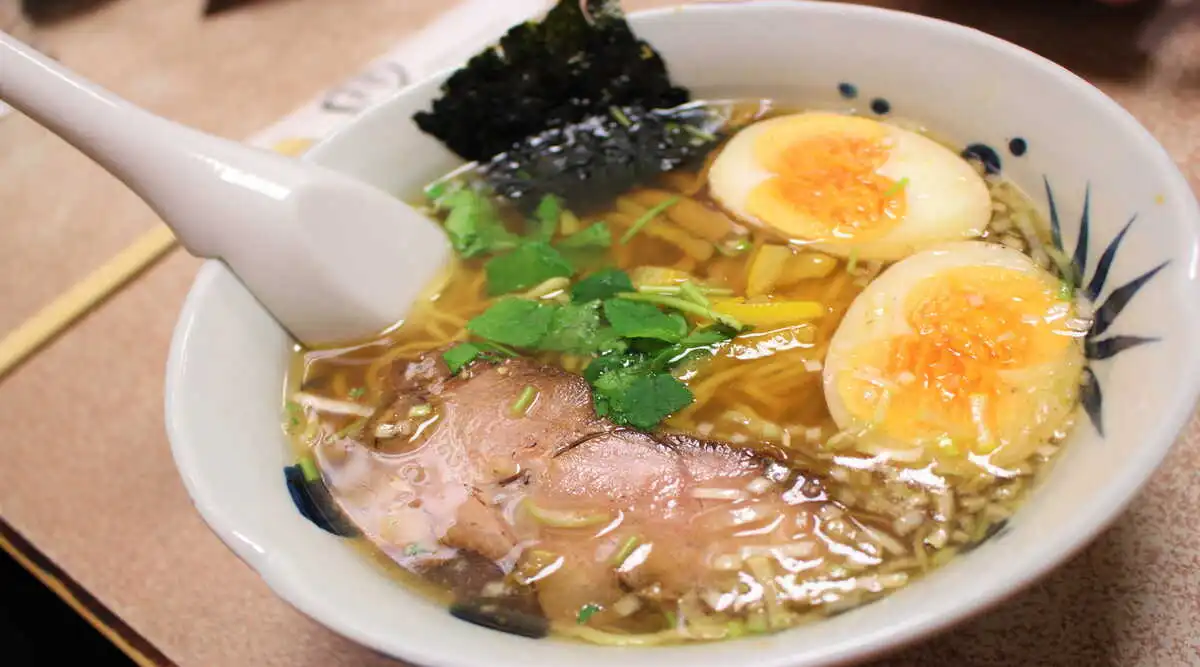Homemade ramen is a personalized version of the popular Japanese dish known as ramen, which is a noodle soup.
Additionally, it can include wheat noodles, broth, and a variety of ingredients, such as: meat, vegetables, egg, seaweed, and seasonings.
When prepared at home, homemade ramen allows you to adapt the recipe according to your preferences and use fresh, high-quality ingredients.
But apart from all these benefits, we have to be if it’s totally healthy for the body. That’s what we’re going to focus on.
Is homemade ramen healthy?
Homemade ramen can be healthy, depending on how you prepare it and the ingredients you use. On the other hand, traditional Japanese ramen, which is often served in restaurants, is made with bone broth, noodles, vegetables, and sometimes meat or seafood.
Also, the processed instant ramen commonly found in supermarkets tends to be less healthy due to its high sodium, saturated fat, and artificial additives.
If you choose homemade ramen over other options, you have the opportunity to control the ingredients and make it healthier. Generally speaking, homemade ramen can be a healthy option if you choose ingredients carefully and control portions.
When you prepare it at home, you have more control over what you consume and therefore, you can adapt it to your personal dietary preferences.
Homemade ramen healthy properties
It is worth noting that homemade ramen can have several healthy properties if it is made properly and nutritious ingredients are chosen.
Here are the healthy properties of homemade ramen:
Control over ingredients
When making ramen at home, you have full control over the ingredients you use, and in this case, you can choose healthier options such as fresh vegetables, lean proteins, and whole-grain carbohydrate sources.
Higher vegetable content
You can add a variety of fresh and healthy vegetables to your homemade ramen: spinach, broccoli, carrots, mushrooms and bamboo shoots, which can increase fiber and nutrient content of your meal.
Homemade broth
Making your own ramen broth allows you to control the amount of sodium and saturated fat it contains. In that sense, you can make a broth based on lean bones or vegetables to reduce fat and salt content.
Lean proteins
Adding lean protein: grilled chicken, tofu, or turkey to ramen. It provides a high-quality protein source without excess saturated fat.
Portion Control
By cooking at home, you can control portions and avoid the extra calories, which is sometimes found in ramen bowls served at restaurants.
Personalization
You can adapt homemade ramen according to your preferences and dietary needs. For example, if you follow a vegetarian or vegan diet, you can make ramen without meat and with vegetable broth.
Fewer additives and preservatives
You avoid common additives and preservatives commonly found in instant or prepackaged versions of ramen.
Seasoning control
You can control the amount of soy sauce, miso, or any other seasoning you add to ramen, allowing you to reduce the amount of sodium.
Inclusion of fermented foods
Adding kimchi or other fermented foods can provide probiotics benefits for gut health.
Healthier variations
There are homemade ramen recipes that use whole wheat noodles instead of refined noodles, which increases fiber and nutrient content.
Although homemade ramen can be a healthier option than instant or restaurant versions loaded with fat and sodium, it’s important to remember that moderation and choosing healthy ingredients are key to maintaining a balanced diet.
Controlling the amount of sodium and saturated fat, as well as balancing your ramen with other nutritious foods, will contribute to a healthier diet.
What is the healthiest type of ramen?
The healthiest type of ramen will depend largely on the specific ingredients and preparation, as this can vary widely in terms of nutritional content and calories.
Here are some general guidelines for choosing a healthier ramen:
- Broth: Opt for vegetable-based broths or lean chicken broth instead of rich, saturated fat broths like pork or duck. Bone-based broths can be flavorful, but are often higher in fat.
- Noodles: Look for whole grain or whole wheat ramen noodles instead of refined noodles. Whole grain noodles contain more fiber and nutrients than processed noodles.
- Protein: Add lean protein to your ramen: grilled chicken, tofu, or boiled egg. Avoid fatty meats like pork or bacon.
- Vegetables: Add a variety of fresh or steamed vegetables to your ramen to increase its vitamin and mineral content. Leafy green vegetables, mushrooms, corn, and bamboo shoots are good options.
- Condiments: Control the amount of soy sauce and other salty condiments you add, as they can increase the amount of sodium. Opt for low-sodium versions if possible.
- Oil: Minimize the amount of oil added in the preparation. Some varieties of ramen are served with spicy oil, which can be delicious but can also increase calories and fat.
- Portions: Control portion size. Ramen is served in large portions in many places.
- Avoid artificial additives: Some instant ramen products contain unhealthy additives and preservatives. If you buy instant ramen, look for options with more natural ingredients and fewer additives.
Remember that enjoying ramen from time to time as part of a balanced diet is acceptable, but it is important not to consume it in excess due to its high sodium and calorie content.
Why is ramen so addicting for some people?
The addictive taste of it for some people is due to several factors:
Umami
Ramen is usually full of umami, the fifth basic flavor after sweet, salty, bitter and sour. Umami is found in ingredients such as bone broth, miso, soy sauce, and mushrooms, and is known to be very satisfying to the palate.
Texture
Ramen noodles have a comforting, satisfying texture when cooked properly, neither too soft nor too firm. Combining the texture of noodles with other ingredients (tender meat, poached egg and crunchy vegetables) can be irresistible.
Variety of flavors and toppings
Ramen can be customized in many different ways, allowing people to choose the ingredients and flavors they like best. This variety of options makes it hard to get bored as you can always try new and exciting combinations.
Aromatic
Ramen broth, often made by cooking pork or chicken bones for hours, takes on a depth of flavor and aroma that is hard to resist. The slow cooking process and the selection of high-quality ingredients contribute to the richness and complexity of the broth.
Comfort food
Ramen is a comfort food that can evoke positive emotions and memories of family meals or special moments. This emotional factor can make it even more addictive for some people.
Visual stimulus
Ramen is often presented in a visually appealing way, with a variety of colors, textures, and shapes on the plate. This can stimulate the appetite and make food more tempting.
Essential seasonings for homemade ramen
Now we’re going to present a list of essential condiments for making homemade ramen:
Ramen broth
Broth is the base of ramen and can be of different types: pork broth (tonkotsu), chicken broth (shoyu), fish broth (shio), or even vegetable broth. The broth is essential to give flavor and body to the dish.
Ramen noodles
Use fresh or dried ramen noodles depending on your preference, you can cook them following the instructions on the package before adding them to the broth.
Toppings
Some examples of popular toppings are:
- Chashu: Roasted or steamed pork, often marinated in soy sauce and mirin.
- Marinated egg: Eggs cooked at low temperature in a mixture of soy sauce, mirin and sake.
- Green onion: Finely chopped green onions for freshness.
- Cooked corn: It adds a special touch to the dish.
- Nori seaweed: Nori seaweed sheets for umami flavor.
- Preserved Bamboo: Preserved bamboo shoots for texture and flavor.
Sesame oil
Toasted sesame oil is used to give flavor and aroma to broth and noodles. Add a few drops just before serving.
Miso paste
Miso paste, either white miso or red miso, is used to flavor the broth. You can dilute it in a little hot broth before adding it to the rest of the broth.
Soy sauce
Soy sauce adds saltiness to the broth and can be adjusted to your personal preference.
Mirin
A sweet rice wine that is used to give a touch of sweetness to broth and dishes.
Sake
Sake can be used both in the broth and in the marinade of some ingredients, such as chashu.
Ginger and garlic paste
These ingredients can add a spicy and aromatic touch to broth or marinades.
Hot chili oil (rayu)
If you like spicy ramen, hot chili oil is an optional condiment that you can add to the broth.
Bonito seaweed powder (katsuobushi)
This seasoning is used to give an umami, fishy flavor to broth and dishes.
Black pepper
A touch of ground black pepper can enhance the flavor of the broth.
Remember that you can customize your homemade ramen according to your personal preferences. Experiment with different ingredients and quantities to create the perfect ramen to your taste.
10 Healthy homemade ramen alternatives
Homemade ramen can be a delicious and healthy option if you choose fresh, balanced ingredients. The following list describes 10 healthy alternatives to this dish:
- Chicken and Vegetable Ramen: Use low-fat chicken broth, whole-grain egg noodles, and a variety of vegetables (spinach, carrots, and mushrooms).
- Miso Ramen: A miso broth base is prepared with whole wheat noodles, firm tofu, and spinach for a touch of green.
- Seafood Ramen: This option uses a light fish broth, fresh shrimp and scallops, and adds nori seaweed and green onion for a touch of umami flavor.
- Vegan Ramen: Opt for a homemade vegetable broth, brown or buckwheat rice noodles, and add marinated tofu, shiitake mushrooms, and bamboo shoots.
- Lean Beef Ramen: Use a lean beef broth, whole grain egg noodles, and add spinach and green onion.
- Roasted pork ramen: Prepare low-fat roast pork broth, whole-grain egg noodles, and add bamboo shoots, corn, and low-temperature cooked egg.
- Turkey Ramen: In this case, you can use a low-fat turkey broth, whole wheat noodles and add broccoli, mushrooms and shredded turkey.
- Spicy Ramen: Add chopped chilies or chili paste to your base broth, along with fresh ingredients like corn, spinach, and tofu.
- Kale and Chickpea Ramen: Replace traditional noodles with cooked chickpeas and add kale, carrots and vegetable broth.
- Thai Curry Ramen: Prepare a broth with coconut milk and Thai curry paste, and add shrimp, peppers, and bamboo shoots.
The key to making healthy ramen is to control portions, choose fresh and balanced ingredients, and moderate the use of oil and salt in preparation. Enjoy your homemade ramen!
Frequently Asked Questions
Of course! You can make homemade ramen with leftover ingredients, as it’s a great way to use what you have in your pantry and refrigerator to create a delicious meal.
Ramen is traditionally made with wheat noodles, which means it contains gluten. Gluten is a protein found in wheat, barley, rye, and other related grains. Therefore, if you have gluten sensitivity or celiac disease, you should be careful with traditional ramen as it can trigger an adverse reaction. However, in these days, you can find gluten-free ramen options on the market.
Definitely, you can freeze homemade ramen to consume later. However, there are some important considerations you should keep in mind to maintain food quality and safety: proper cooling, proper packaging, product labeling and dating, safe thawing, and proper reheating.
Some popular garnishes for homemade ramen are as follows: Marinated egg (Ajitsuke Tamago), nori seaweed, chopped green onion, preserved bamboo shoots, corn, mushrooms (shiitakes, mushrooms and enoki), cornstarch (cornstarch), sesame oil, pork chashu, menma , chopped leek, Kimchi.
Some ideal dressings for remen are: Sesame oil, soy sauce, rice vinegar, miso paste, rayu or chili oil, furikake, minced garlic, grated ginger, toasted sesame, and onion chopped green.
Conclusion
Generally speaking, choosing homemade ramen allows you to have more control over the ingredients to adapt it to create a healthy version.
You can experiment with different ingredients and cooking techniques to achieve the flavor and texture you like best.
So, we want you to keep in mind the beneficial aspect of choosing homemade ramen:
- Control over ingredients (fresh vegetables, lean proteins and whole carbohydrate sources).
- Higher content of vegetables (spinach, broccoli, carrots, mushrooms and bamboo shoots).
- Soupy and aromatic.
- Lean proteins (grilled chicken, tofu or turkey).
- Portion control.
- Personalization according to your preferences and dietary needs.
- Fewer additives and preservatives.
- Control of seasonings.
- Inclusion of fermented foods.
- Healthier variations.
Remember, this can be a fun and creative way to experiment with Asian cuisine at home.

A. Neomar Evies es un profesor graduado y licenciado en informática. Investigador y conferencista que ha participado en diferentes eventos en diversos países. Tiene amplia experiencia en el campo de la gestión deportiva y el deporte de alto rendimiento y salud deportiva del atleta. También tiene un doctorado en Ciencias del Deporte y un Máster en administración. Como escritor ha escrito tres libros sobre sistemas de información centrados en Gestión y Deportes.





